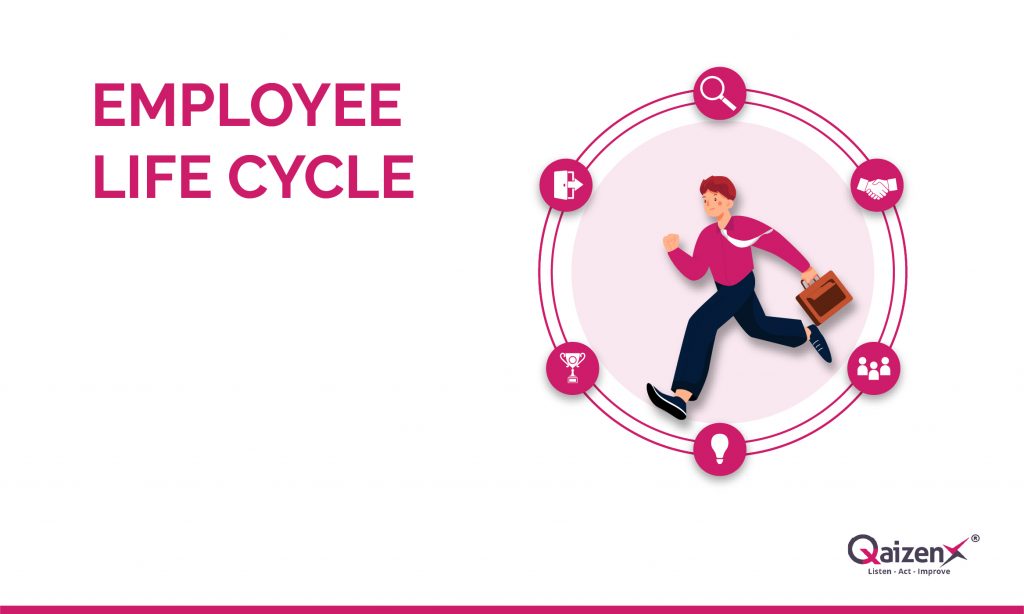The 6 Key Stages of Employee Life Cycle

Each and every employee at your organization has a unique story that has shaped them and, in turn, influenced your organization in some way. Understanding these journeys – and how your organization can improve them – is crucial to creating a better work culture.
There are several phases an employee goes through within an organization known as the Employee Life Cycle. Starting from employees seeing the job post online to getting their last paycheque.
Let’s understand what’s Employee Life Cycle in detail and how each phase impacts the organization:
What is the Employee Life Cycle?
An employee life cycle is a learning strategy by which organizations divide each stage of an employee into different parts in order to improve the overall employee experience.
The existence cycle starts when an employee finds out about an organization or open position forges ahead through their enlistment, recruiting and onboarding into their time working for the organization. Lastly, stretches out to their exit and post-business experience.
Employee life cycle also depends on your industry and the work environment you have. Nonetheless, the general way from employing to exit is frequently comparable, paying little heed to the finished work.
To get what the employee life cycle comprises, how about we view all the stages exhaustively.
1. Attraction
The most critical phase of an employee’s life cycle is the attraction stage. Regardless of how solid and imaginative your product or service is, your organization will continue to endure misfortunes without the attraction of top-talented newcomers who are ideal for your job.
Hence, drawing in competitors is of the most vital phases of any organization’s prosperity methodology. This stage is the sole stage that happens even before an organization has a vacant position. In other words, it is a projection of the picture depicted of an organization.
They attempt to describe their brand emphatically and show the potential newcomers why it would be a great work environment. To attract talented newcomers, there are sure tips that each organization should follow. For example, raising brand awareness among people and work culture.
Nowadays, having a decent work culture is essential for each organization as the workforce is overwhelmed by twenty to thirty-year-olds. Also, they cannot be able in negative or bad working culture.
So, to attract people to your organization, you need to work on these two basic ideas. And you will surely get some talented people for your company.
2. Recruitment
The second phase of the employee life cycle is the employing system. This is the cycle when the HRs scrutinize and enlist the best possibility for their organization. Recruiting can either be for a current vacant position or creating another position by assuming the newcomer is worth the effort. There are a couple of tips that organizations ought to follow for guaranteeing fruitful enrollment. For example, making a robust reference program.
Perhaps an ideal way to observe an unspoiled newcomer is to request references from your current employees. As they probably are aware of the organization and its way of life in and out, they will realize who is the most ideal for the specific position. Nobody would do this for nothing. So, the organization ought to make a referral program where the employees get a reward if their alluded applicant gets chosen.
And there can be other ways to recruit an employee. But any which way, it is a significant stage in the employee life cycle.
3. Onboarding

The third phase of the employee life cycle is onboarding. This is an interaction where the recently recruited employees get training to find out about the organization, its objectives, approaches, and work.
It is extremely important to ensure that the employee’s qualities and targets are lined up with the organization’s.
The onboarding stage is essential as in this stage employees get to know what precisely they will be functioning. Also the amount they are esteemed, which thus helps the organization in holding them.
4. Development
The following phase of the employee life cycle is the development stage. During this time, the businesses urge the new employees to be a part of the group and work effectively and beneficially. They additionally assist employees with job skills development. This is part of the new employee engaging techniques.
5. Retention
The second-last phase of the employee life cycle is holding the best employees. In this stage, the organizations make an honest effort to hold the employees that are an essential resource for them. If you know how to measure employee satisfaction and implement the correct strategy, your employees will remain in the organization for the long run.
Organizations must take endeavors to retain their best employees. This should be possible when the managers know the requirements of each employee and attempt to satisfy them.
6. Exit / Separation

The last phase of the employee life cycle is partitioning from the organization. For some employees, there comes a moment when their work life cycle concludes. Regardless of whether from new business, retirement, or other individual reasons, they leave their organization at a certain point. The companies must treat the division stage similarly to the onboarding stage as it sets a genuine model for the existing employees.
The managers ought to consistently hold the employee, assuming the explanation is disappointment with the job. Taking note, they should release them in the best way imaginable. This expands the believability of the organization monstrously.
So, these are the 6 stages of an employee life cycle, which every organization goes through every now and then.
Why it is important?
Looking into and arranging around life cycle stages can assist your business with further developing the general employee experience, which helps the company in numerous ways, from more useful employees to further developed client steadfastness.
Two of the employee life cycle stages most obviously attached to the primary achievement concern are participation and retention. If you can keep employees around longer, you’ll have fewer situations to occupy over the long run.
Your good management of the recruitment cycle can help you save too.
Contingent upon how you gauge and deal with the cycle, enlistment expense can be a lot higher for a fresh recruit.
When an employee completes the process of training—which can be very costly by its own doing once you factor in their compensation, in addition to the payment of some other staff member associated with training—they might foster business-explicit ability that makes them considerably more significant. As an employee’s information and skills develop, keeping them might be a test, yet it should, in any case, be the objective and something you pursue.
Any way you measure it, getting new employees is costly. Keeping employees happy and connected can assist with broadening the average time employees stay at your organization. That is why further developing employee life cycle management could lastingly affect an organization’s future.
With QaizenX, make your employees’ experiences count at every stage of their life cycle.
Recent Posts
- How People Analytics Can Utilize Data to Drive Business Results
- The Role of AI in Enhancing Employee Feedback Systems
- How Purpose-Built AI Can Help You Build A Great Customer Experience
- Why is Customer Sentiment Analysis Crucial to Your Business?
- Customer Experience Statistics You Need To Know for 2025 | CX Statistics 2024



